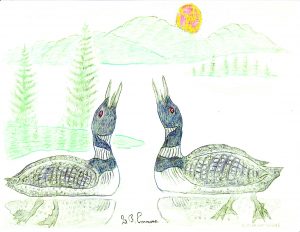The common loon is one of the oldest living creatures on this planet, with credentials of ancient fossils written on limestone pages of time in Earth’s crust more than a billion years ago.
This iconic spirit of the waters we enjoy today has somehow miraculously eluded extinction both before and after the Mesozoic cataclysms because of land and water amphibian adeptness of survival that is still apparent today with their behavior of clever elusive capacity.
The name ‘loon’ is derived from the Scandinavian “lom,” meaning clumsy or lame, in reference to their limited mobility on land with legs farther back on their body like other vertebrates such as frogs and salamanders, to lead a successful double life as an amphibian.
That is why the loon nests at the water’s edge. Unable to stand, it slides on its belly like aquatic reptiles like the alligator. But then once in or under the water, it is a powerful swimmer, propelled by webbed feet shaped like scuba diver flippers and helped by underwater flapping wings, and is able to dive down to 200 feet where its diaphragm constricts under pressure to minimize oxygen requirement to stay under for almost a full minute. Then, surfacing in an unpredictable direction, it can cruise along in a partially submerged depth with only the eye in the top of the head showing like the periscope of a submarine.
But all too soon, it must migrate to the ocean well before ice forms, from which it cannot take off for flight. That is when we see it here, having turned a salty color to adapt to the habitat.
Fortunately, the loon population has come back to be relatively stable to overcome man-made detrimental conditions such as acid rain, chemicals in the water, nesting disturbances, ingestion of poisonous lead fishing weights, and power boat mortality. Most effective remedial results have been the mission of public awareness, plus subsequent State and Federal regulation initiated by the Loon Preservation Society of Moultonborough, New Hampshire on Lake Winnipesaukee where my wife and I spent last week on our annual vacation.
Upon arrival, during our stay, and for our departure, we like to think the loon’s calling seems to acknowledge and enhance our presence annually for many years. This may be much the same as the aging couple in the movie On Golden Pond on Squam Lake nearby.
Henry David Thoreau described the call of the loon as the most unearthly sound he had ever heard. There are two calls. There is the wail that seems to mourn the passage of time and memories of past summer seasons on the lake. But even more soulful is the shrill warning tremolo yodel that alerts us to the bygone miracle of creation on Lake Winnipesaukee, which in Native American means “smile of the great spirit.”
With all this, my mission of this article and drawing is to share with you this message of the loon as a living barometer of a healthy aquatic environment.
By George B. Emmons
